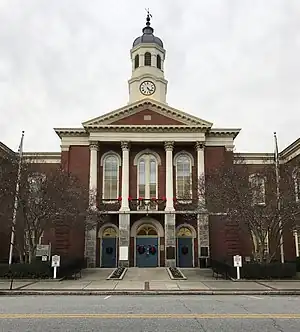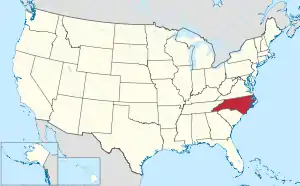Pasquotank County | |
|---|---|
 Pasquotank County Courthouse | |
 Seal | |
 Location within the U.S. state of North Carolina | |
 North Carolina's location within the U.S. | |
| Coordinates: 36°15′55″N 76°15′38″W / 36.265199°N 76.260691°W | |
| Country | |
| State | |
| Founded | 1668 |
| Named for | Indian word meaning "where the current of the stream divides or forks"[1] |
| Seat | Elizabeth City |
| Largest community | Elizabeth City |
| Area | |
| • Total | 289.33 sq mi (749.4 km2) |
| • Land | 226.88 sq mi (587.6 km2) |
| • Water | 62.45 sq mi (161.7 km2) 21.58% |
| Population (2020) | |
| • Total | 40,568 |
| • Estimate (2022) | 40,938 |
| • Density | 178.81/sq mi (69.04/km2) |
| Time zone | UTC−5 (Eastern) |
| • Summer (DST) | UTC−4 (EDT) |
| Congressional district | 1st |
| Website | www |
Pasquotank County (PAS-kwoh-tayngk /ˈpæs.kwoʊ.teɪŋk/ ⓘ)[2] is a county located in the U.S. state of North Carolina. As of the 2020 census, the population was 40,568.[3] Its county seat is Elizabeth City.[4]
Pasquotank County is part of the Elizabeth City, NC Micropolitan Statistical Area, which is also included in the Virginia Beach-Chesapeake, VA-NC Combined Statistical Area.[5]
History
The county was originally created as Pasquotank Precinct and gained county status in 1739.[6] The largest community and county seat is Elizabeth City.
Geography
According to the U.S. Census Bureau, the county has a total area of 289.33 square miles (749.4 km2), of which 226.88 square miles (587.6 km2) is land and 62.45 square miles (161.7 km2) (21.58%) is water.[7] It is the fifth-smallest county in North Carolina by land area.
Almost all of the terrain in Pasquotank County is flatland with a topography near sea level, a characteristic of most of North Carolina's Coastal Plain. The county is flanked by two rivers: the Pasquotank and the Little River.
National protected area
State and Local protected site
Major water bodies
- Albemarle Sound
- Big Flatty Creek
- Intracoastal Waterway
- Little River
- Newbegun Creek
- Pasquotank River
Adjacent counties
- Tyrrell County – south
- Camden County – east
- Perquimans County – southwest
- Gates County – northwest
Major highways
Major infrastructure
Demographics
| Census | Pop. | Note | %± |
|---|---|---|---|
| 1790 | 5,477 | — | |
| 1800 | 5,379 | −1.8% | |
| 1810 | 7,674 | 42.7% | |
| 1820 | 8,008 | 4.4% | |
| 1830 | 8,641 | 7.9% | |
| 1840 | 8,514 | −1.5% | |
| 1850 | 8,950 | 5.1% | |
| 1860 | 8,940 | −0.1% | |
| 1870 | 8,131 | −9.0% | |
| 1880 | 10,369 | 27.5% | |
| 1890 | 10,748 | 3.7% | |
| 1900 | 13,660 | 27.1% | |
| 1910 | 16,693 | 22.2% | |
| 1920 | 17,670 | 5.9% | |
| 1930 | 19,143 | 8.3% | |
| 1940 | 20,568 | 7.4% | |
| 1950 | 24,347 | 18.4% | |
| 1960 | 25,630 | 5.3% | |
| 1970 | 26,824 | 4.7% | |
| 1980 | 28,462 | 6.1% | |
| 1990 | 31,298 | 10.0% | |
| 2000 | 34,895 | 11.5% | |
| 2010 | 40,661 | 16.5% | |
| 2020 | 40,568 | −0.2% | |
| 2022 (est.) | 40,938 | [3] | 0.9% |
| U.S. Decennial Census[8] 1790–1960[9] 1900–1990[10] 1990–2000[11] 2010[12] 2020[3] | |||
2020 census
| Race | Number | Percentage |
|---|---|---|
| White (non-Hispanic) | 21,577 | 53.19% |
| Black or African American (non-Hispanic) | 14,316 | 35.29% |
| Native American | 150 | 0.37% |
| Asian | 458 | 1.13% |
| Pacific Islander | 28 | 0.07% |
| Other/Mixed | 1,802 | 4.44% |
| Hispanic or Latino | 2,237 | 5.51% |
As of the 2020 census, there were 40,568 people, 14,697 households, and 9,829 families residing in the county.
2010 census
At the 2010 census,[14] there were 40,661 people, 13,907 households, and 9,687 families residing in the county. The population density was 154 people per square mile (59 people/km2). There were 14,289 housing units at an average density of 63 units per square mile (24 units/km2). The racial makeup of the county was 56.7% White, 37.8% Black or African American, 0.3% Native American, 1.1% Asian, 0.0% Pacific Islander, 1.8% from other races, and 2.2% from two or more races. 4.0% of the population were Hispanic or Latino of any race.
There were 12,907 households, out of which 33.4% had children under the age of 18 living with them, 50.4% were married couples living together, 16.3% had a female householder with no husband present, and 29.5% were non-families. 25.4% of all households were made up of individuals, and 11.4% had someone living alone who was 65 years of age or older. The average household size was 2.52 and the average family size was 3.01.
In the county, the population was spread out, with 24.9% under the age of 18, 11.3% from 18 to 24, 28.4% from 25 to 44, 21.3% from 45 to 64, and 14.1% who were 65 years of age or older. The median age was 36 years. For every 100 females there were 93.8 males. For every 100 females age 18 and over, there were 90.1 males.
The median income for a household in the county was $30,444, and the median income for a family was $36,402. Males had a median income of $30,072 versus $21,652 for females. The per capita income for the county was $14,815. 18.4% of the population and 15.5% of families were below the poverty line. Out of the total people living in poverty, 25.5% are under the age of 18 and 17.9% are 65 or older.
Government and politics
Pasquotank County is a member of the Albemarle Commission regional council of governments.
| Year | Republican | Democratic | Third party | |||
|---|---|---|---|---|---|---|
| No. | % | No. | % | No. | % | |
| 2020 | 9,770 | 49.10% | 9,832 | 49.41% | 295 | 1.48% |
| 2016 | 8,180 | 47.04% | 8,615 | 49.54% | 596 | 3.43% |
| 2012 | 7,633 | 42.15% | 10,282 | 56.78% | 192 | 1.06% |
| 2008 | 7,778 | 42.78% | 10,272 | 56.50% | 130 | 0.72% |
| 2004 | 6,609 | 48.42% | 6,984 | 51.17% | 55 | 0.40% |
| 2000 | 4,943 | 45.34% | 5,874 | 53.88% | 86 | 0.79% |
| 1996 | 2,999 | 38.34% | 4,233 | 54.12% | 590 | 7.54% |
| 1992 | 3,419 | 35.69% | 4,709 | 49.15% | 1,453 | 15.17% |
| 1988 | 4,006 | 50.76% | 3,860 | 48.91% | 26 | 0.33% |
| 1984 | 4,646 | 54.58% | 3,854 | 45.27% | 13 | 0.15% |
| 1980 | 3,340 | 43.39% | 4,128 | 53.62% | 230 | 2.99% |
| 1976 | 2,651 | 37.89% | 4,302 | 61.49% | 43 | 0.61% |
| 1972 | 3,906 | 63.07% | 2,115 | 34.15% | 172 | 2.78% |
| 1968 | 1,430 | 18.84% | 2,564 | 33.78% | 3,597 | 47.39% |
| 1964 | 2,380 | 35.79% | 4,269 | 64.21% | 0 | 0.00% |
| 1960 | 1,827 | 28.74% | 4,530 | 71.26% | 0 | 0.00% |
| 1956 | 1,827 | 38.14% | 2,963 | 61.86% | 0 | 0.00% |
| 1952 | 2,101 | 36.99% | 3,579 | 63.01% | 0 | 0.00% |
| 1948 | 701 | 24.04% | 1,976 | 67.76% | 239 | 8.20% |
| 1944 | 860 | 25.29% | 2,540 | 74.71% | 0 | 0.00% |
| 1940 | 506 | 13.25% | 3,314 | 86.75% | 0 | 0.00% |
| 1936 | 324 | 9.13% | 3,226 | 90.87% | 0 | 0.00% |
| 1932 | 328 | 9.96% | 2,946 | 89.49% | 18 | 0.55% |
| 1928 | 814 | 29.52% | 1,943 | 70.48% | 0 | 0.00% |
| 1924 | 305 | 19.64% | 1,236 | 79.59% | 12 | 0.77% |
| 1920 | 507 | 22.60% | 1,736 | 77.40% | 0 | 0.00% |
| 1916 | 270 | 18.65% | 1,177 | 81.28% | 1 | 0.07% |
| 1912 | 77 | 6.24% | 972 | 78.83% | 184 | 14.92% |
Education
Schools in Pasquotank county include College of The Albemarle, Elizabeth City State University, Mid-Atlantic Christian University, and Pasquotank County High School.
Communities

City
- Elizabeth City (county seat and largest community)
Unincorporated communities
Townships
- Elizabeth City
- Mount Hermon
- Newland
- Nixonton
- Providence
- Salem
See also
References
- ↑ "Pasquotank County, North Carolina". www.carolana.com. Retrieved August 30, 2022.
- ↑ Talk Like A Tarheel Archived 2013-06-22 at the Wayback Machine, from the North Carolina Collection's website at the University of North Carolina at Chapel Hill. Retrieved 2012-09-18.
- 1 2 3 "QuickFacts: Pasquotank County, North Carolina". United States Census Bureau. Retrieved May 31, 2022.
- ↑ "Find a County". National Association of Counties. Retrieved June 7, 2011.
- ↑ "OMB Bulletin No. 23-01: Revised Delineations of Metropolitan Statistical Areas, Micropolitan Statistical Areas, and Combined Statistical Areas, and Guidance on Uses of the Delineations of These Areas" (PDF). United States Office of Management and Budget. July 21, 2023. Retrieved August 10, 2023.
- ↑ "North Carolina: Individual County Chronologies". North Carolina Atlas of Historical County Boundaries. The Newberry Library. 2009. Archived from the original on March 4, 2016. Retrieved January 25, 2015.
- ↑ "2020 County Gazetteer Files – North Carolina". United States Census Bureau. August 23, 2022. Retrieved September 9, 2023.
- ↑ "U.S. Decennial Census". United States Census Bureau. Retrieved January 18, 2015.
- ↑ "Historical Census Browser". University of Virginia Library. Retrieved January 18, 2015.
- ↑ Forstall, Richard L., ed. (March 27, 1995). "Population of Counties by Decennial Census: 1900 to 1990". United States Census Bureau. Retrieved January 18, 2015.
- ↑ "Census 2000 PHC-T-4. Ranking Tables for Counties: 1990 and 2000" (PDF). United States Census Bureau. April 2, 2001. Archived (PDF) from the original on March 27, 2010. Retrieved January 18, 2015.
- ↑ "State & County QuickFacts". United States Census Bureau. Archived from the original on June 7, 2011. Retrieved October 29, 2013.
- ↑ "Explore Census Data". data.census.gov. Retrieved December 22, 2021.
- ↑ "U.S. Census website". United States Census Bureau. Retrieved January 31, 2008.
- ↑ Leip, David. "Dave Leip's Atlas of U.S. Presidential Elections". uselectionatlas.org. Retrieved March 17, 2018.
External links
 Geographic data related to Pasquotank County, North Carolina at OpenStreetMap
Geographic data related to Pasquotank County, North Carolina at OpenStreetMap- Official website
